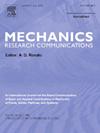基于FFT相场断裂的有效韧性估计:在复合材料和多晶中的应用
IF 2.3
4区 工程技术
Q3 MECHANICS
引用次数: 0
摘要
提出了一种基于相场断裂模型的非均质材料有效韧性估计方法。该估计是基于对微观结构中具有代表性的体积单元的变形的模拟,通过使用弧长型控制来控制恒定的能量耗散率。韧性的定义对应于RVE总断裂后耗散的总能量(通过耗散控制可以精确得到)除以RVE横向面积(二维长度)。所提出的估计既考虑了韧性和弹性响应的非均质性对总断裂能的影响,也考虑了各向异性弹性和断裂响应(解理断裂)的相。为了提高韧性预测,采用裂纹尖端富集来模拟初始裂纹。应用该方法计算了复合材料和弹性多晶的有效韧性。在这两种材料中,发现弹性响应的非均质性和断裂能都有助于提高有效韧性。微观上,发现裂纹增韧机制与裂纹在较硬相中的扩展和裂纹路径的偏离有关。在非均质性和各向异性较强的情况下,后者是控制机理,在非均质性或各向异性足够大的情况下,最终导致增韧作用饱和。本文章由计算机程序翻译,如有差异,请以英文原文为准。
Effective toughness estimation by FFT based phase field fracture: Application to composites and polycrystals
An estimate of the effective toughness of heterogeneous materials is proposed based on the Phase Field Fracture model implemented in an FFT homogenization solver. The estimate is based on the simulation of the deformation of representative volume elements of the microstructure, controlled by a constant energy dissipation rate using an arc-length type control. The definition of the toughness corresponds to the total energy dissipated after the total fracture of the RVE — which can be accurately obtained thanks to the dissipation control — divided by the RVE transverse area (length in 2D). The proposed estimate accounts for both the effect of heterogeneity in toughness and elastic response on the overall fracture energy and allows as well to account for phases with anisotropic elastic and fracture response (fracture by cleavage). To improve toughness predictions, crack-tip enrichment is used to model initial cracks. The method is applied to obtain the effective toughness of composites and elastic polycrystals in a series of examples. In the two types of materials, it is found that both heterogeneity in elastic response and fracture energy contribute to increase the effective toughness. Microscopically, it is found that toughening mechanisms are related to the propagation of the crack through tougher phases and the deviation of the crack path. It is also found that the latter is the controlling mechanism for cases with marked heterogeneity and high anisotropy, eventually leading to the saturation of the toughening effect for sufficiently high values of heterogeneity or anisotropy.
求助全文
通过发布文献求助,成功后即可免费获取论文全文。
去求助
来源期刊
CiteScore
4.10
自引率
4.20%
发文量
114
审稿时长
9 months
期刊介绍:
Mechanics Research Communications publishes, as rapidly as possible, peer-reviewed manuscripts of high standards but restricted length. It aims to provide:
• a fast means of communication
• an exchange of ideas among workers in mechanics
• an effective method of bringing new results quickly to the public
• an informal vehicle for the discussion
• of ideas that may still be in the formative stages
The field of Mechanics will be understood to encompass the behavior of continua, fluids, solids, particles and their mixtures. Submissions must contain a strong, novel contribution to the field of mechanics, and ideally should be focused on current issues in the field involving theoretical, experimental and/or applied research, preferably within the broad expertise encompassed by the Board of Associate Editors. Deviations from these areas should be discussed in advance with the Editor-in-Chief.

 求助内容:
求助内容: 应助结果提醒方式:
应助结果提醒方式:


